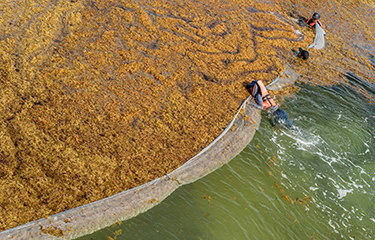A huge belt of sargassum, a seaweed that originates in the Sargasso Sea, is anticipated to wash up on shores in Florida, states bordering the Gulf of Mexico, and Caribbean islands this summer.
A report by the University of South Florida’s Optical Oceanography Lab determined that more than 24 million metric tons of sargassum has collected in the Atlantic as of June 2022, one of the largest amounts in history. USA today reports visitors to Florida, Caribbean, and the Gulf of Mexico might encounter the sargassum as massive amounts of smelly, brown seaweed washed ashore.
Sargassum is composed of macroalgae which floats in large masses in the Sargasso Sea. Floating in the ocean it’s harmless to humans, but when it washes ashore it decomposes and produces hydrogen sulfide gas and ammonia, which smells like rotten eggs and can cause irritation to eyes, throat, and nose.
The massive belts of seaweed can also cause problems for the fishing industry. NOAA classifies it as an Essential Fish Habitat, ensuring it has special collection protections. It cannot be removed directly from the ocean, it must wash ashore prior to collection.
The seaweed is a normal presence in the ocean, but factors like climate change and inflows of nitrogen and man-made fertilizer have caused a drastic increase in the amounts of sargassum washing ashore.
Higher volumes of seaweed typically wash ashore from March to October, but it could show increased visibility ahead of schedule – particularly in Key West, Florida U.S.A. and Cancun, Mexico.
Photo courtesy of Bret Reyes/Shutterstock







